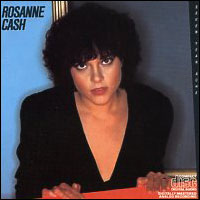| Seven Year Ache | ||||
|---|---|---|---|---|
 | ||||
| Studio album by | ||||
| Released | February 27, 1981 | |||
| Recorded | 1980 | |||
| Studio |
| |||
| Genre | Country | |||
| Length | 32:45 | |||
| Label | Columbia (United States/Canada) Ariola (international) | |||
| Producer | Rodney Crowell | |||
| Rosanne Cash chronology | ||||
| ||||
| Singles from Seven Year Ache | ||||
| ||||
| Review scores | |
|---|---|
| Source | Rating |
| AllMusic | |
| Rolling Stone | |
| Stylus Magazine | B+[3] |
| Uncut | 8/10[4] |
| The Village Voice | B+[5] |
Seven Year Ache is the third studio album by American country music singer Rosanne Cash, and her second for Columbia Records. It was released on February 27, 1981, and reached number one on the Billboard country album chart.[6] Three singles were released from her album; in the order of the singles' release they were: the title track, My Baby Thinks He's a Train, and Blue Moon with Heartache. To promote the album, Cash hit the talk show circuit starting with her appearance on The Merv Griffin Show. The album was mastered a few days following the murder of John Lennon. As a tribute to Lennon, Cash asked the mastering engineer to scratch the message “Goodbye, John” into the run-out groove of the mother vinyl. This etching was limited to the first 25,000 copies of the album.[citation needed]
The CD was reissued in 2005 in an edition which was part of the American Milestone series from Sony BMG, which later identified the reissue as being among the 52 CD titles that were deemed to have been shipped with Extended Copy Protection (XCP) computer software.[7][8] As a result, all Microsoft Windows computer that were used to play the reissue are likely to have had XCP installed. This can cause a number of serious security problems. Several security software vendors, including Microsoft, regard XCP as a trojan horse, spyware, or rootkit.[9] Sony discontinued use of the technology on November 11, 2005,[10] and recalled this and other titles affected by XCP, and asked customers to submit copies affected by the software to the company so that it could replace them with copies that did not contain the software.[11]
- ^ Jurek, Thom. "Seven Year Ache – Rosanne Cash". AllMusic. Retrieved July 22, 2023.
- ^ Tucker, Ken (June 11, 1981). "Rosanne Cash: Seven Year Ache". Rolling Stone. Archived from the original on September 8, 2008. Retrieved July 22, 2023.
- ^ Soto, Alfred (February 10, 2006). "Rosanne Cash – Seven-Year Ache / King's Record Shop / Interiors". Stylus Magazine. Archived from the original on April 27, 2006. Retrieved July 22, 2023.
- ^ Torn, Luke (January 2014). "How to Buy... Rosanne Cash". Uncut. No. 200. p. 66.
- ^ Christgau, Robert (June 29, 1981). "Christgau's Consumer Guide". The Village Voice. Retrieved July 22, 2023.
- ^ "Chart history for Seven Year Ache". Allmusic. Retrieved November 23, 2010.
- ^ List of titles affected by XCP
- ^ "Sony officially lists 52 XCP infected CDs & faces a loss of sales". Archived from the original on 2011-07-22. Retrieved 2010-07-30.
- ^ "Microsoft to Zap Sony DRM Rootkit". eWEEK. 12 November 2005.
- ^ "Breaking News, Business News, Financial and Investing News & More - Reuters.co.uk". arquivo.pt. Archived from the original on 2009-12-23.
- ^ Graham, Jefferson (2005-11-14). "Sony to pull controversial CDs, offer swap". USA Today. Retrieved 2010-05-02.